
-
Find the right food for your pet
Take this quiz to see which food may be the best for your furry friend.
Find the right food for your pet
Take this quiz to see which food may be the best for your furry friend.
Featured products
 Adult 7+ Perfect Digestion Chicken, Whole Oats & Brown Rice Recipe Dog Food
Adult 7+ Perfect Digestion Chicken, Whole Oats & Brown Rice Recipe Dog FoodScience Diet's breakthrough nutrition supports ultimate digestive well-being & healthy microbiome for dogs age 7+
Shop Now Adult Healthy Cuisine Roasted Chicken, Carrots & Spinach Stew Dog Food
Adult Healthy Cuisine Roasted Chicken, Carrots & Spinach Stew Dog FoodDelicious roasted chicken paired with tender vegetables in a succulent stew
Shop Now Small & Mini Savory Stew with Chicken & Vegetables Dog Food
Small & Mini Savory Stew with Chicken & Vegetables Dog FoodA delicious complement to the nutrition of Science Diet Small & Mini 7+ dog food
Shop NowFeatured products
 Adult 7+ Tender Tuna Dinner Cat Food
Adult 7+ Tender Tuna Dinner Cat FoodWith delicious chunks in a decadent gravy
Shop Now Adult 7+ Senior Vitality Chicken & Vegetable Stew Cat Food
Adult 7+ Senior Vitality Chicken & Vegetable Stew Cat FoodImproves Everyday Ability to Get Up & Go
Shop Now Adult Savory Entrée Can Variety Pack Cat Food
Adult Savory Entrée Can Variety Pack Cat FoodPrecisely balanced nutrition with the delicious taste of savory minced chicken to help fuel the energy needs of cats during the prime of their life
Shop Now -
Dog
- Dog Tips & Articles
-
Health Category
- Weight
- Food & Environmental Sensitivities
- Urinary
- Digestive
- Joint
- Kidney
-
Life Stage
- Puppy Nutrition
- Adult Nutrition
- Senior Nutrition
Cat
- Cat Tips & Articles
-
Health Category
- Weight
- Skin & Food Sensitivities
- Urinary
- Digestive
- Kidney
-
Life Stage
- Kitten Nutrition
- Adult Nutrition
Featured articles
 Why Are Dogs and Cats So Cute?
Why Are Dogs and Cats So Cute?If waggy puppy dog tails and furry kitten yawns make you swoon, you're not alone. Why are cats so cute? And, dogs too! Let's find out!
Read More Do Dogs and Cats have Belly Buttons?
Do Dogs and Cats have Belly Buttons?Learn whether cats & dogs have belly buttons like humans, what the function is, and if there are any health concerns associated with it.
Read More Does My Pet Hate Me?
Does My Pet Hate Me?Learn tips for bonding with your pet if you've ever thought, 'My dog doesn't like me, or 'Why do I have a standoffish cat?'
Read More -


While acne may seem like a skin issue for just humans, feline acne isn't just possible — it's actually quite common. Just as in humans, acne tends to occur on feline faces, preferentially affecting the chin and lip margins.
In most cases of cat chin acne, pet parents report the appearance of a "dirty chin" or grungy debris accumulating on the chin. Typically, clustered toward the front of the chin or around the lip margins, acne lesions are often tiny, non-painful and present little more than a cosmetic nuisance. Some cats, however, can be severely afflicted and may even benefit from the services of a veterinary dermatologist. Let's take a closer look at cat acne.
Causes of Acne in Cats
No one knows what exactly causes feline acne, but it's clear that it happens when hair follicles in the chin or around the lips become clogged. Excessive production of sebum (an oily substance produced by the skin's sebaceous glands) may be involved as too much sebum can predispose follicles to getting clogged.
Some proposed associated causes of feline acne include:
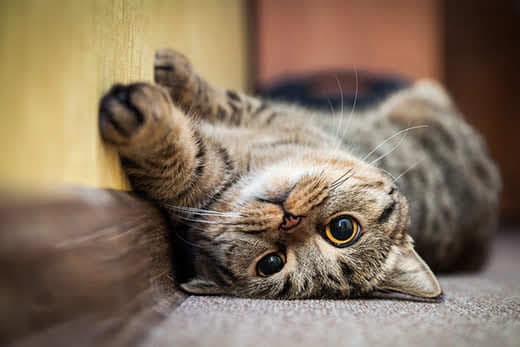
- Skin allergies (seasonal or to foods)
- Contact hypersensitivity (typically to plastic)
- Excessive scent marking
- Stress
- Viruses such as calicivirus and herpes virus
- Poor grooming habits
There are also other diseases such as demodicosis (mange), ring worm and other types of allergic reactions that may appear similar to feline acne and should be ruled out by your veterinarian. Acne can affect cats of all breeds. While a genetic predisposition may exist, no direct link has yet demonstrated that this disease is an inherited condition.
Clinical Signs of Feline Acne
Acne in cats isn't always easy to spot. While even mild feline chin acne will readily stand out in cats with white or light-colored fur, it may not be so obvious in cats with darker coats. Normally, acne may appear as little black dots on the chin or lip margins. These comedones (blackheads) can appear bumpy, crusty or just dirty. Fur may be missing in these areas, and the affected skin may be raised and bumpy or swollen and reddened.
In more severely affected cats, the entire chin area or lip margins may be swollen, red and/or missing fur. Instead of tiny black dots, draining pustules over thickened skin are typically evident in these cats. Spots of blood may even be spied on their nearby fur or on objects they choose to rub against. If the acne is severe, these cats may paw at the area or rub vigorously against objects, but most appear unfazed by acne. It is not considered especially itchy or painful.
Cats with more severe forms of feline acne often have other skin issues to contend with. These can include other areas of hairlessness, redness or bumpy crusting. Excessive grooming or obvious itchiness is possible, too. Allergic skin disease is, after all, a major predisposing factor in cases of feline acne.
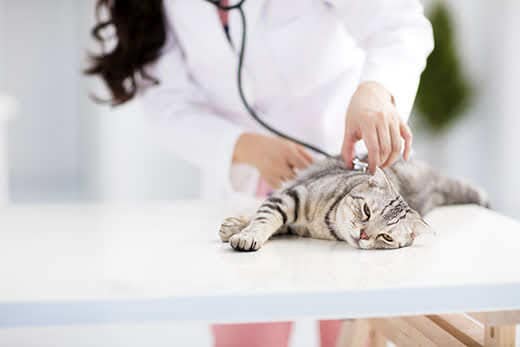


Tasty Tips
Treating Acne in Cats
If the acne isn't bothering your cat, then treatment may not be necessary. However, even in these cats, simple treatments such as daily cleaning of the affected area with antibacterial wipes (prescribed by your veterinarian) or switching to feeding out of ceramic or metal bowls cleaned daily with soap and water can help. For more significantly affected cats, your veterinarian may recommend additional treatment. Acne might sound like a simple condition, but just as in humans, it's not always easy to treat. Treatment options include both topical and systemic medications. While topical preparations are always preferable due to the lower probability of side effects, systemic medications are sometimes necessary for either behavioral reasons or by medical necessity.
Topical treatments include antibiotics, anti-inflammatory medications (corticosteroids), antifungal medications and antiseptics along with ministrations like applying warm compresses or surgically lancing and draining. These procedures are typically reserved for larger and deeper lesions. Systemic options include oral or injectable antibiotics, oral antifungal drugs and oral or injectable anti-inflammatory options.
For cats with underlying diseases, particularly those with skin allergies, treatment might remain elusive unless these processes are successfully addressed.
Preventing Feline Acne
As with most difficult-to-treat diseases, prevention is the ideal approach. Here are a few considerations:
- Treat any underlying issues, such as allergies, skin infections or other skin conditions.
- Remove any plastic objects that may come into contact with your cat, especially food bowls.
- Keep all porous objects your cat comes into regular contact with as clean as possible. Wash toys and food bowls regularly.
- Since evidence shows that some cats with acne may not groom as efficiently as others, keeping them clean can be helpful. Brushing, bathing and disinfecting the chin and lip area may be beneficial as well.
As always, speak to your veterinarian about treatment and prevention of feline acne. In some severe cases, your vet will recommend that you seek out the services of a board-certified veterinary dermatologist. These vets are uniquely qualified to assess and treat conditions like persistent acne. If your cat is severely affected and solutions elude you, ask your vet about seeing a credentialed dermatologist. You'll have your feline best friend looking and feeling fine in no time.


Dr. Patty Khuly is an award-winning veterinarian known for her independent thinking, her spirited pet advocacy, her passion for the veterinary profession, and her famously irreverent pet health writing.
Dr. K is an honors graduate of both Wellesley College and the University of Pennsylvania School of Veterinary Medicine. She received her MBA at The Wharton School of Business as part of the prestigious VMD/MBA dual-degree program. She now owns Sunset Animal Clinic, a veterinary practice in Miami, Florida.
Related products
Related articles
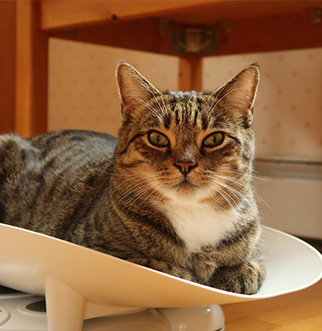
How do you get a cat to lose weight? Learn all about cat foods for weight loss, including how to choose weight control cat food and exercise tips.
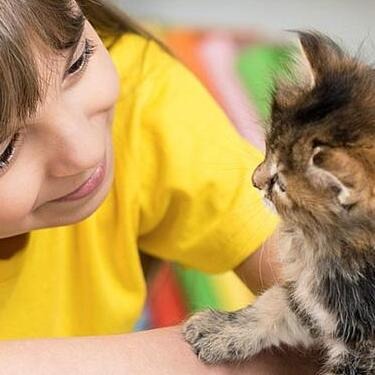
Discover how to train your cat, starting with very basic first steps that both reward good behavior and discourage the bad.
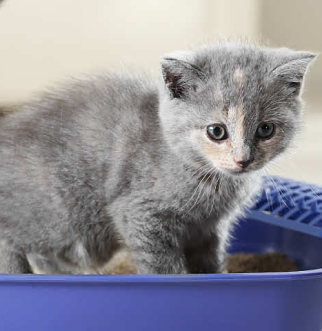
Cats are naturally very clean and chances are your kitten will already have learned how to use the litter box from her mother before she comes to live with you.
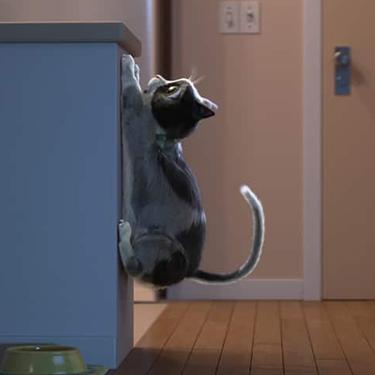
What is the best food for an overweight cat? Learn all about weight control food for cats, including what's in it and how it works.

Put your cat on a diet without them knowing
Our low calorie formula helps you control your cat's weight. It's packed with high-quality protein for building lean muscles, and made with purposeful ingredients for a flavorful, nutritious meal. Clinically proven antioxidants, Vitamin C+E, help promote a healthy immune system.
Put your cat on a diet without them knowing
Our low calorie formula helps you control your cat's weight. It's packed with high-quality protein for building lean muscles, and made with purposeful ingredients for a flavorful, nutritious meal. Clinically proven antioxidants, Vitamin C+E, help promote a healthy immune system.

